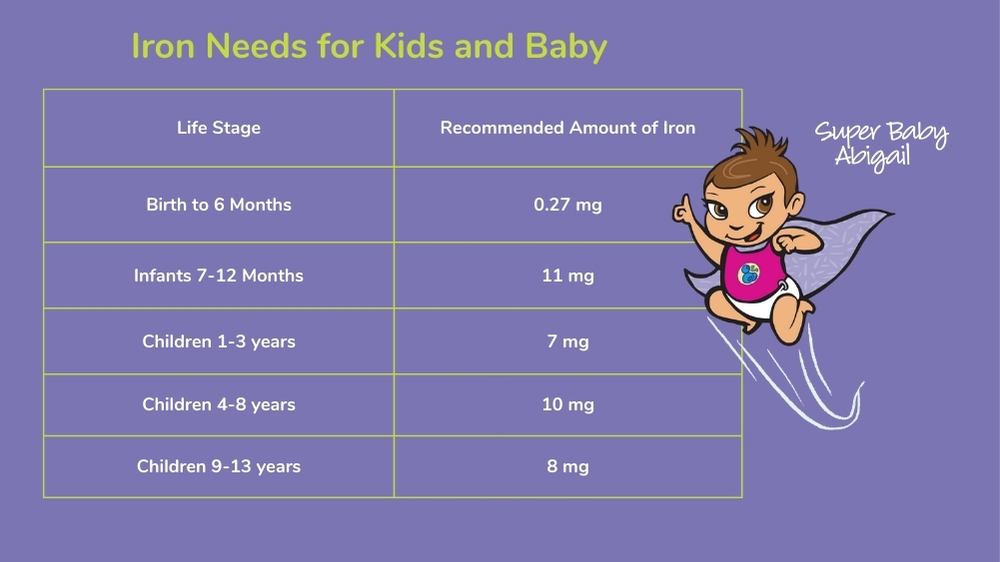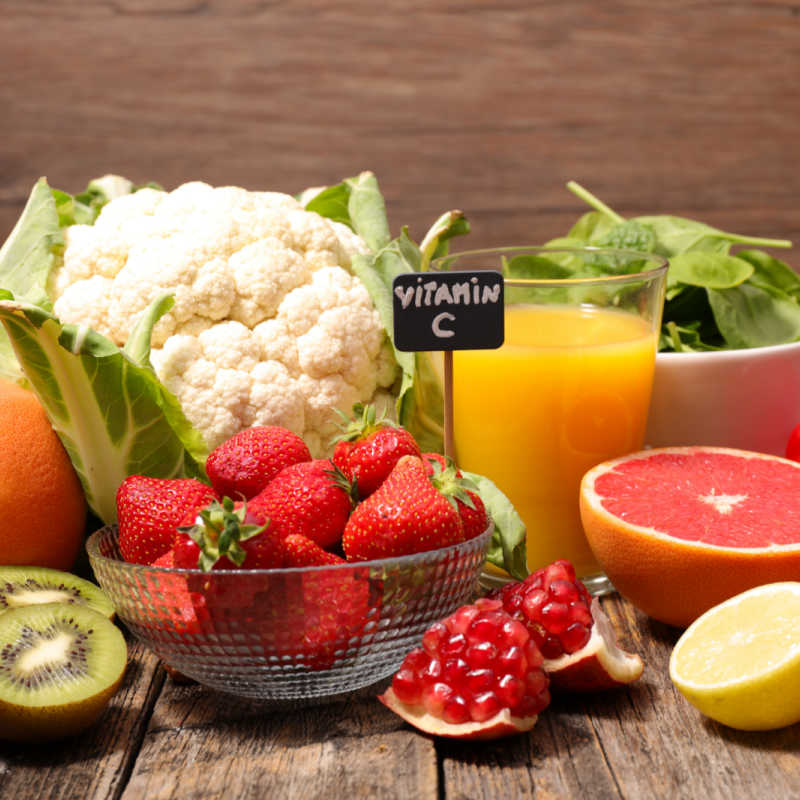
Feel confident about your mealtime choices by learning about iron needs and iron-rich foods for kids and babies.
Infants, toddlers, and adolescents bud faster than flowers, leading to increased nutrient needs. Specifically, iron deficiency in children can lead to a decline in cognitive and psychological development. (1) But, ferrous not! By learning about iron foods for kids, you can push those worries aside.
Reaching your children’s recommended iron intake is easy-peasy when you know these tips and tricks. Use this helpful guide to boost iron-rich foods for babies and kids to enable healthy development now for a positive life-lasting impact.
What is Iron?
Ironically, although iron is a trace element it plays far from a minuscule role. After all…Iron Man is a force to be reckoned with! This nutrient helps your young child grow as healthy and mighty as their favorite superhero. The primary function of iron is to deliver oxygen from the lungs to the body tissues while also providing energy. Talk about important tasks.
Why is Iron Important for Babies and Children?
Cue the “magic school bus” for a refresher anatomy lesson on the role of iron. This trace element is essential to form hemoglobin and oxygen-carrying red blood cells. Hemoglobin is a protein found in red blood cells that transports oxygen from the lungs to your whole body. It’s also what makes our blood red! Finally, iron is necessary to form myoglobin—a type of protein that carries and stores oxygen in the muscle tissue.
Because of its critical role, iron is necessary for physical growth, brain development, and several hormone syntheses in babies and children. (1) Having low-iron levels can affect a child’s concentration and memory, making learning a struggle.
Recommended Iron Intake Per Day (1)
Infants, young children, and teenage girls are at the highest risk of iron deficiency. Depending on their age and gender, little ones need different amounts of iron from their diet. Use this guide to determine the daily iron recommendations for your child:
| Life Stage | Recommended Amount of Iron (mg) |
|---|---|
| Birth to 6 months | 0.27 mg |
| Infants 7-12 months | 11 mg |
| Children 1-3 years | 7 mg |
| Children 4-8 years | 10 mg |
| Children 9-13 years | 8 mg |
Pin this for Later

Iron in Breastmilk – Keep This in Mind
If you are strictly sticking to breastfeeding, keep in mind that human milk contains minimal iron with low bioavailability. So, the recommendation is to supplement 1mg/kg of your baby’s body weight per day with an oral form of iron, beginning at four months of age, or until your baby is ready for iron-containing complementary foods such as fortified cereals. (1)
Within the first few months of life, babies don’t require supplementation since they have built up stores from mama bear’s third trimester. But premature babies can be at risk of low iron levels within these first four months. For parents whose little one entered the world before expected, talk to your doctor about your premature baby’s iron needs. (4)
A preterm infant that is primarily breastfed may need to be supplemented with 2 mg/kg/day iron between 1 and 12 months of age. (1)
Iron Needs for Baby When Partially Breastfeeding
If your baby feeding routine is a mix-and-match, where you partially breastfeed (more than half of the time), your infant has the same iron supplement recommendations as little ones who get exclusively breastfed.
If you decide or need to formula feed your baby, opt for an iron-fortified formula through the first year of life. (2)
What are Iron Deficiency Symptoms in Children?
Don’t get defeated; iron deficiency anemia can get prevented through strategic meal choices. If your child falls short of their needs, it can negatively affect their health and development. So, it’s important to learn the signs. Common iron deficiency symptoms in children include:
- having pale skin
- fatigue
- poor appetite
- growth delays
- and being uncharacteristically fussy.
Know the signs to prevent the symptoms by being proactive about your child’s iron intake. Engage at your regular health care check-ups and ask for a referral to a registered dietitian when nutrition concerns present.
Lab Values – Iron Deficient Children
If you suspect that your child may be deficient in iron, talk to your pediatrician. They may order a variety of blood tests to confirm the diagnosis. If a child is iron deficient, the following lab values will be high or low:
| Lab Value | Its Purpose | Value with Deficiency |
| Serum ferritin | your body’s iron stores | will be low |
| Hemoglobin | protein that carries oxygen | will be low |
| Hematocrit | the calculated volume percentage of red blood cells (erythrocytes) in your blood | will be low |
| Serum iron | amount of iron in your blood | will be low |
| Transferrin saturation | protein in the blood that binds to iron to transport it | will be low |
| Soluble serum transferrin receptor (STFR) | transports iron into your cells | will be high |
| Total iron-binding capacity (TIBC) | amount of iron that can bind to blood | will be high |
If your child has anemia, ferritin levels will typically be less than 10-12 mg/L and hemoglobin less than 11mg/dL (4, 5). Note the values may differ depending on the laboratory.
Supplementing Iron Drops for Kids- Speak With Your Pediatrician
Speak with your pediatrician to better understand your child’s lab test results. They may prescribe your child iron drops to help boost their iron levels. Unfortunately, the drops are not a fan-favorite due to their less than desirable taste.
Take the struggle out of supplementation, and experiment with adding the drops in an ounce of orange juice. But if your child’s iron is only slightly low, supplementation won’t be necessary. Instead, pediatricians will suggest fueling with iron-rich foods.
Safety Tip! Too much of anything is never a good thing. For example, over supplementing with iron can poison your child. So, be sure to keep iron pills and drops out of reach and safely stored away from children.
Check out Keeping Iron Intake in Check to learn more about preventing anemia.
Heme Iron vs. Non-Heme Iron
Differentiate the two forms of dietary iron in iron foods for kids: heme iron and non-heme iron.
- Heme iron: can be readily absorbed by the body. It only comes from animal proteins like meat, poultry, eggs, and seafood.
- Non-heme iron: is found in plant-based foods like grain products, legumes, fruits, and green leafy vegetables. Since the body doesn’t readily absorb non-heme iron, the recommendation for vegetarians is to eat almost twice (1.8 times) as much as the amounts listed in the table below. (1)
When in Doubt, Add Vitamin C for Iron Absorption
Reaching the recommended iron intake for babies and children is as easy as ABC. Or, in this case: add a boost of Vitamin C. This powerful nutrient helps make the most of iron-rich foods by increasing the body’s absorption of the non-heme iron found in plants.
There are a lot of convenient foods abundant in vitamin C that go beyond simply adding oranges to every meal. For instance, other foods high in vitamin C include red bell pepper, kiwi, grapefruit, broccoli, strawberries, cabbage, cauliflower, Brussel sprouts, and tomatoes. (1) Need some food-spiration? Try this kiwi-filled smoothie or cauliflower soup!

Iron Foods for Kids
Here are examples of heme versus non-heme iron sources: (1,3)
| Plant Sources (Non-Heme) | Iron (mg) |
|---|---|
| Fortified breakfast cereals, 1 cup | Up to 18 |
| Spinach, 1 cup, cooked | 6.4 mg |
| Tofu, 1/2 cup, cooked | 3.3 mg |
| Lentils, 1/2 cup, cooked | 3.3 mg |
| Pumpkin seeds, 1/4 cup | 2.4 mg |
| White beans, 1/2 cup, canned | 1.8 mg |
| Kidney beans, 1/2 cup, cooked | 2.6 mg |
| Oats, 1/2 cup, uncooked | 1.8 mg |
| Animal Sources (Heme) | Iron (mg) |
|---|---|
| Sardines, 1 oz. | 1.5 mg |
| Ground beef, 1 oz. | 0.7 mg |
| Tuna, 1 oz. canned in water | 0.32 mg |
| Egg, 1 whole | 0.96 mg |
| Chicken breast, 1 oz. | 2.7 mg |
Tips for Preventing Iron Deficiency in Children
Other than focusing on the iron foods for kids mentioned above, here are a few other tips to keep in mind.
- Do not feed your baby with cow’s milk before the first birthday.
- After 12 months of age, limit the consumption of cow’s milk products to less than 16 ounces (2 cups) per day. Cow’s milk is low in iron, and its calcium content can decrease the absorption of iron from other foods. (6) If your child only wants milk, meet with a dietitian to help introduce new foods in a variety of ways to help your child meet all their nutritional needs.
- Kids shouldn’t be drinking coffee or caffeinated tea. Both contain tannins, which are organic compounds that reduce the absorption of iron. However, herbal tea is good.
- Use cast-iron pots and skillets. Fun fact, cooking with cast-iron cookware is a simple way to add a boost of iron to your food.
- Offer iron-fortified cereals and other fortified grain products.
- Offer a well-balanced diet with iron-rich foods. Don’t forget that iron is present in plant-based ingredients such as fortified grains and cereals, legumes, and leafy greens.
You don’t need to be an iron-chef to help your child reach their recommended iron intake. With these strategic iron-rich food choices, you can give your youngster the nutritious tools to blossom into healthy kids.












